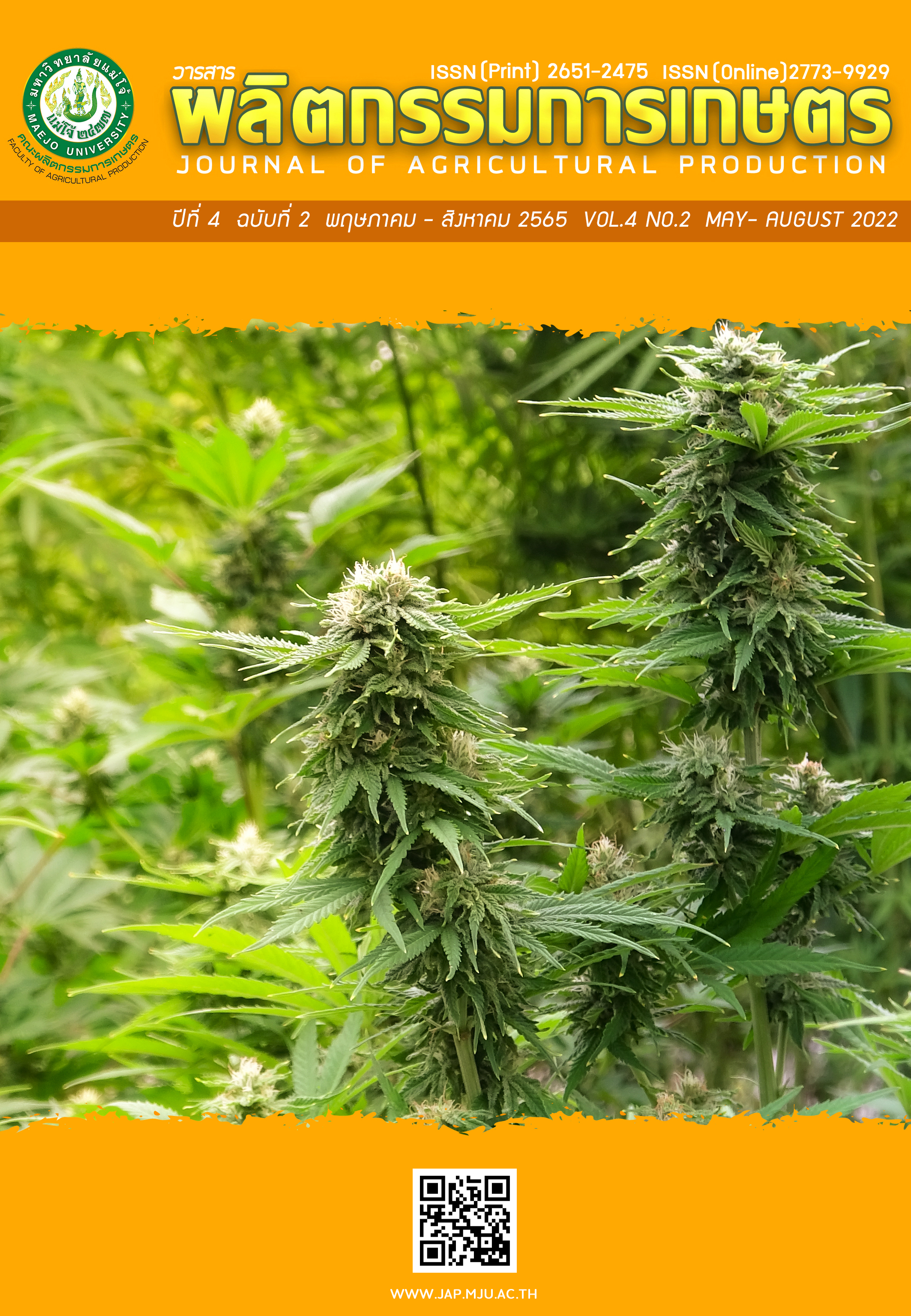การวิเคราะห์สหสัมพันธ์และเส้นทางความสัมพันธ์ของข้าวไร่ต่อลักษณะของผลผลิต ในพื้นที่ลูกคลื่นลอนลาด ในอำเภอนาคู จังหวัดกาฬสินธุ์
Main Article Content
บทคัดย่อ
การประเมินสายพันธุ์ข้าวไร่จำนวน 22 สายพันธุ์ และ 2 พันธุ์ควบคุม ในอำเภอนาคู จังหวัดกาฬสินธุ์ มีวัตถุประสงค์เพื่อศึกษาสายพันธุ์ข้าวที่มีผลผลิตสูง และความสัมพันธ์ระหว่างลักษณะ อิทธิพลทางตรง และทางอ้อมที่มีต่อผลผลิตของข้าว วางแผนการทดลองแบบสุ่มภายในบล็อกสมบูรณ์ (RCBD) จำนวน 3 ซ้ำ ผลการทดลองพบว่า จำนวนหน่อต่อกอ 6.00-20.33 หน่อต่อกอ ความสูงต้น 56.22-125.91 เซนติเมตร จำนวนรวงต่อกอ 3.33-11.67 รวงต่อกอ ความยาวรวง 20.39-30.00 เซนติเมตร จำนวนเมล็ดต่อรวง 38.67-148.67 เมล็ด ความกว้างเมล็ด 2.04-3.42 มิลลิเมตร ความยาวเมล็ด 8.42-11.43 มิลลิเมตร น้ำหนัก 100 เมล็ด 1.90-3.18 กรัม น้ำหนักเมล็ดต่อกอ 2.90 -35.00 กรัม และผลผลิต 64.87-676.33 กิโลกรัมต่อไร่ โดย Rice 153 Rice 207 และ Rice 193 มีผลผลิตต่อไร่มากที่สุดเท่ากับ 676.33, 464.10 และ 367.07 กิโลกรัมต่อไร่ จำนวนรวงต่อกอมีความสัมพันธ์ทางบวกกับน้ำหนักเมล็ดต่อกอ (r=+0.64) และผลผลิตต่อไร่ (r=+0.64) ความยาวรวงมีความสัมพันธ์ทางบวกกับจำนวนเมล็ดต่อรวง (r=+0.68) น้ำหนักเมล็ดต่อกอ (r=+0.74) และผลผลิตต่อไร่ (r=+0.72) น้ำหนักเมล็ดต่อกอมีความสัมพันธ์ทางบวกกับผลผลิตต่อไร่ (r=+0.99) และการวิเคราะห์ความสัมพันธ์ระหว่างองค์ประกอบผลผลิตกับผลผลิต พบว่าอิทธิพลโดยตรงทางบวกต่อผลผลิต คือ น้ำหนักเมล็ดต่อกอ ความสูง ความกว้าง ความยาวเมล็ดและน้ำหนัก 100 เมล็ดต่อต้น คือ 1.0054 0.0258 0.0273 0.0251 และ 0.0037 ตามลำดับ
Article Details

อนุญาตภายใต้เงื่อนไข Creative Commons Attribution-NonCommercial-NoDerivatives 4.0 International License.
เอกสารอ้างอิง
กรมการข้าว. 2554. การจำแนกลักษณะพันธุ์ข้าว. กรมการข้าว กระทรวงเกษตรและสหกรณ์, กรุงเทพฯ.
กรมพัฒนาที่ดิน. 2564. หนังสืออิเล็กทรอนิกส์ กรมพัฒนาที่ดิน. แหล่งข้อมูล http://e-library.ldd.go.th/library/flip/bib9296f/bib9296f.html#p=48 (19 สิงหาคม 2564).
นิภาภรณ์ สีทาพุฒ. 2560. การประเมินสายพันธุ์ข้าวพื้นเมืองเพื่อปลูกในจังหวัดอุดรธานี. วิทยานิพนธ์ระดับปริญญาโท, คณะทรัพยากรธรรมชาติและอุตสาหกรรมเกษตร, มหาวิทยาลัยเกษตรศาสตร์, สกลนคร.
สำนักงานจังหวัดกาฬสินธุ์. 2563. สรุปข้อมูลจังหวัดกาฬสินธุ์. แหล่งข้อมูล http://www.kalasin.go.th/basicInfo/mobile/index.html#p=13 (20 พฤศจิกายน 2563).
สำนักวิจัยและพัฒนาข้าว กรมการข้าว. 2563. พันธุ์ข้าว. แหล่งข้อมูล http://www.ricethailand.go.th/Rkb/varieties/index.php-file=content.php&id=7.htm (18 กันยายน 2563).
Abebe, T., S. Alamerew and L. Tulu. 2019. Traits association and path coefficient analysis of yield and related traits in rainfed lowland rice (Oryza sativa L.) genotypes in North Western Ethiopia. Afr. J. Plant Sci. 13(1): 1-8.
Bagati, S., A.K. Singh, R.K. Salgotra, R. Bhardwaj, M. Sharma, S.K. Rai and A. Bhat. 2016. Genetic variability, heritability and correlation coefficients of yield and its component traits in basmati rice (Oryza sativa L.). Sabrao J. Breed. Genet. 48(4): 445-452.
Custodio, M.C., R.P. Cuevas, J. Ynion, A.G. Laborte, M.L. Velasco and M. Demont. 2019. Rice quality: How is it defined by consumers, industry, food scientists and geneticists. Trends Food Sci. Technol. 92: 122-137.
Dinesh, P.S, A. Pandey, D.C. Bhandari, O.P. Dhariwal and S.K. Sharma. 2014. Variability study in seed morphology and uses of indigenous rice landraces (Oryza sativa L.) collected from West Bengal, India. Aust. J. Crop Sci. 8 (3): 460-467.
Hasan, MD. J., M.U. Kulsum, S.J. Mohiuddin and MD.Z.AL. Rafiq. 2019. Genetic interrelationship among yield and its components in rice hybrids. Bangladesh J. Bot. 48(4): 1207-1213.
Johnson, R. and P. Kuby. 2012. Elementary Statistics. Cengage Learning, Inc., U.S.A.
Kumar, V., N. Koshta, N, Sohgaura and G.K. Koutu. 2014. Genetic evaluation of RILs population for yield and quality attributing traits in rice (Oryza sativa L.). J. Agri. Technol. 1(1): 43-51.
Kumar, S., M.P. Chauhan, A. Tomar, R.K. Kasana and N. Kumar. 2018. Correlation and path coefficient analysis in rice (Oryza sativa L.). J. Pharm. Innov. 7(6): 20-26.
Nithya, N., R. Beena, R. Stephen, P.S. Abida, V.G. Jayalekshmi, M.M. Viji and R.V. Manju. 2020. Genetic variability, heritability, correlation coefficient and path analysis of morphophysiological and yield related traits of rice under drought stress. Chem. Sci. Rev. Lett. 9(33): 48-54.
Oladosu, Y., M.Y. Rafii, U. Magaji, N. Abdullah, G. Miah, S.C. Chukwu, G. Hussin, A. Ramli and I. Kareem. 2018. Genotypic and phenotypic relationship among yield components in rice under tropical conditions. Biomed Res. Int. 201: 1-10.
Raboina, L.M., T. Randriambololona, T. Radanielina, A. Ramanantsoanirina, N. Ahmadi and J. Dusserre. 2014. Upland rice varieties for mallholder farming in the cold conditions in Madagascar’s tropical highlands. Field Crops Res. 169: 11–20.
Roy, S.K., M.Y. Li, M.A. Hakim, M.M. Hanafi, A.S. Juraimi, M.S. Jahan, U.K. Saha, M.A. Alam and M.A. Kashem. 2014. Evaluation of growth and yield potentialities of local boro rice varieties in south-west region of Bangladesh. Life Sci. J. 11(10): 277-281.
Seyoum, M., S. Alamerew and K. Bantte. 2012. Genetic variability, heritability, correlation coefficient and path analysis for yield related traits in upland rice (Oryza sativa L.). J. Plant Sci. 7(1): 13-22.
Sivasankar, R., B.G. Suresh, S. Ashish and T.R. Sudheer. 2018. Correlation and path coefficient analysis in elite germplasm of rice (Oryza sativa L.). Int. J. Curr. Microbiol. Appl. Sci. 7(7): 3454-3459.
The R foundation. 2021. The R Project for Statistical Computing. Available: https://www.r-project.org/ (August 30, 2021).
Ullah, M.Z., M.K. Bashar, M.S.R. Bhuiyan, M. Khalequzzaman and M.J. Hasan. 2011. Interrelationship and cause-effect analysis among morpho-physiological traits in birion rice of Bangjadesh. Int. J. Plant Breed. Genet. 5(3): 246-254.


